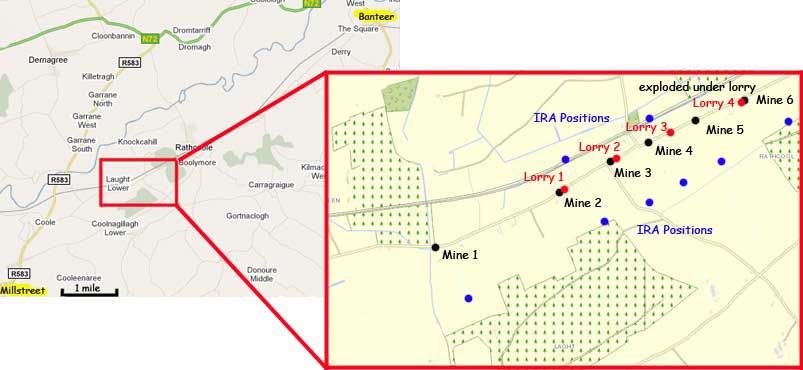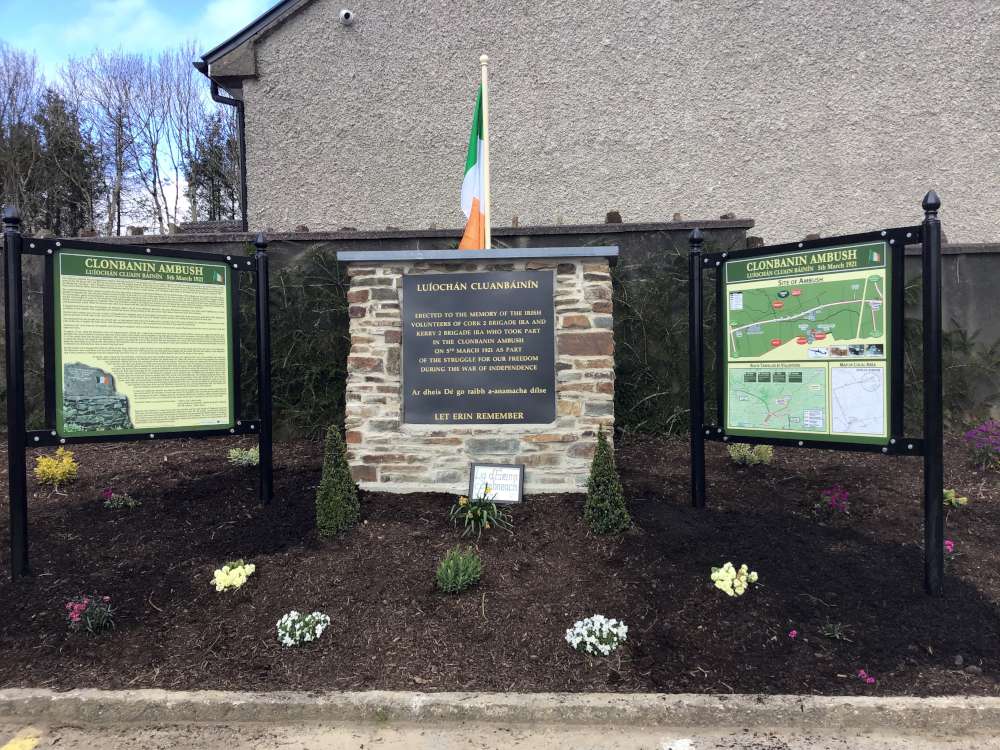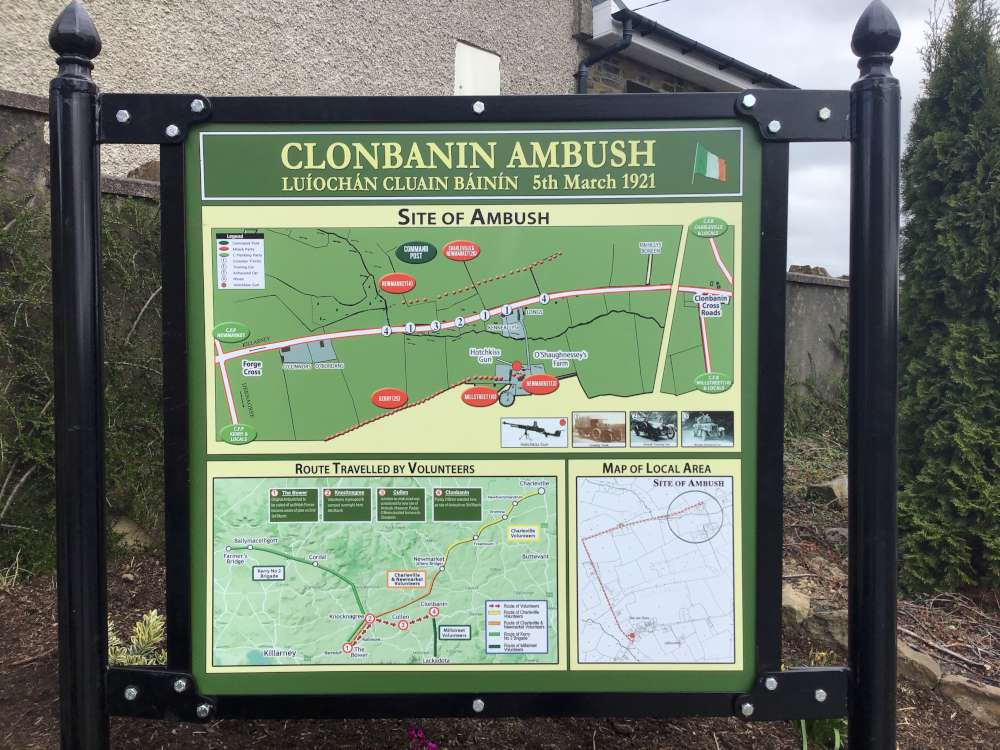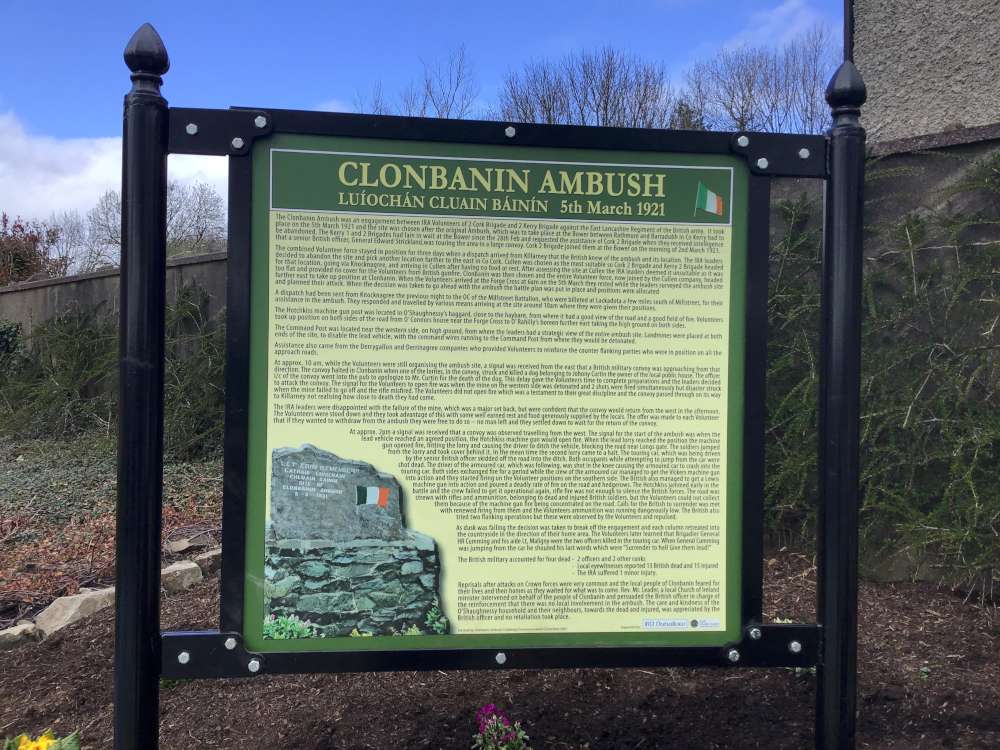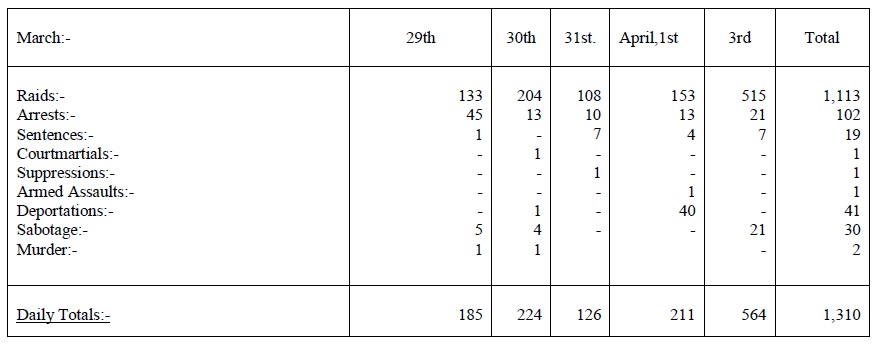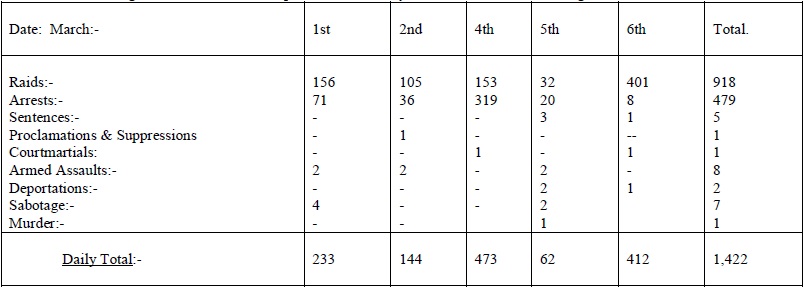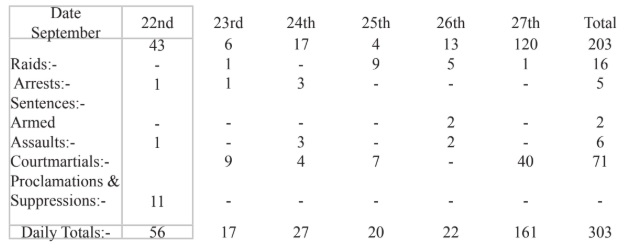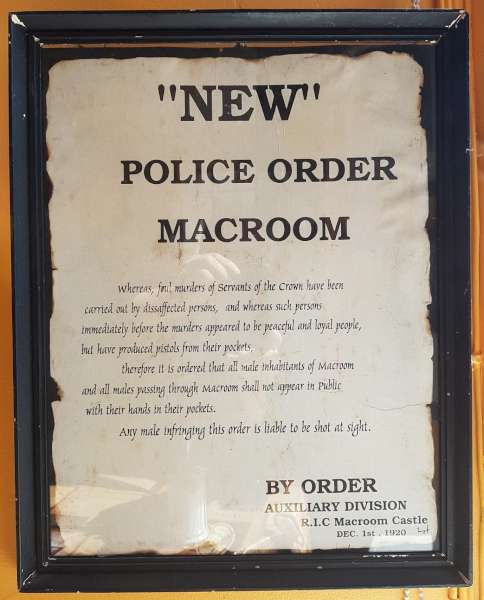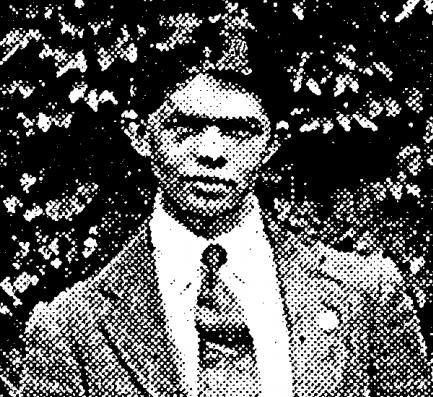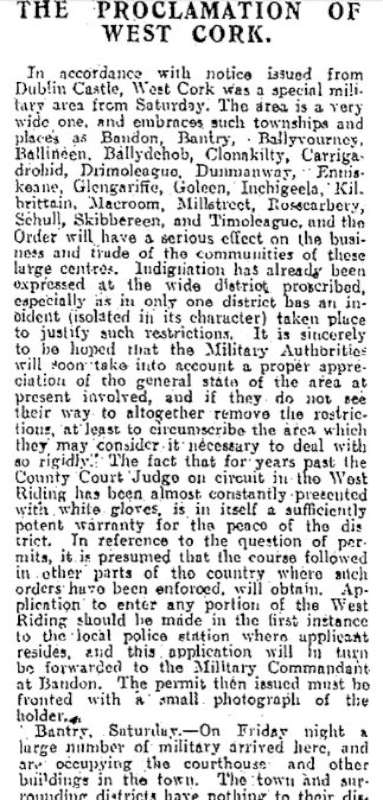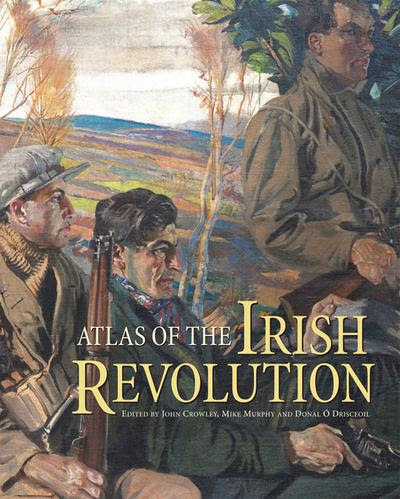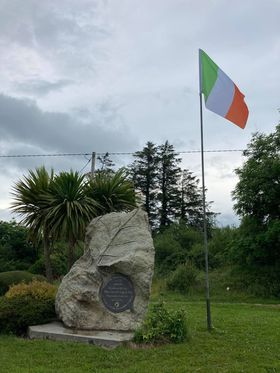 The tricolour flies proudly at the Captain Con Murphy monument in Ballydaly marking the centenary of the Truce at the end of the War of Independence, that led to the freedom and peace that we enjoy today on this island.
The tricolour flies proudly at the Captain Con Murphy monument in Ballydaly marking the centenary of the Truce at the end of the War of Independence, that led to the freedom and peace that we enjoy today on this island.
Tag: War of Independence
100th Anniversary of the Killing of Frank Creedon
Mikie Dinneen, Murdered 100 years ago today at Tooreenbawn
In the aftermath of the Rathcoole ambush a week earlier, where two Auxiliaries were killed, and many wounded, the British forces conducted the biggest sweep of any area in the south of Ireland, looking for IRA suspects. Early on the morning of the 24th of June 1921 I.R.A. Volunteer Michael Dineen from the Kilcorney Company County Cork was taken from his brother’s house in Ivale, and shot in the back multiple times just 300m away.
The British Commandant instructed that no inquest was to take place as such action would have risked lives unnecessarily of local forces.
His funeral was probably the largest ever seen locally, and he was buried in Millstreet Church Graveyard (along the path, just down from the sacristy door).
Pictured above is the memorial at the site of his murder in Tooreenbawn.
For more information on Mikie Dineen, and what happened, we recommend these: [read more …] “Mikie Dinneen, Murdered 100 years ago today at Tooreenbawn”
George H.S. Duckham (1900-1921)
 On June 22nd 1921, George H.S. Duckham, was returning to Millstreet from leave in London where he had been married just a week earlier. A young R.I.C. constable in Millstreet, he had rested in Macroom Barrack overnight, and was making his way in plain clothes on a horse and side-car to Millstreet. It was at the height of the war of Independence, and unfortunately for him, the IRA knew he was coming and they ambushed him between Macroom and Carriganima at Carriganeigh Cross. They took him prisoner and apparently found on him amongst other things, a list of the names of the members of the Millstreet Battalion Column that were to be shot on sight. On top of that, as a constable he apparently had a bad record in the eyes of the local republicans. He was tried by the IRA and shot. His body was left across the river from Carriganima Church, but apparently taken away and buried in a bog elsewhere by locals who were afraid that the police would cause trouble in the area. His body was never found and remains a mystery. He left behind a young wife and a young son, also named George Henry Samuel Duckham. Wherever his body lies, may he rest in peace.
On June 22nd 1921, George H.S. Duckham, was returning to Millstreet from leave in London where he had been married just a week earlier. A young R.I.C. constable in Millstreet, he had rested in Macroom Barrack overnight, and was making his way in plain clothes on a horse and side-car to Millstreet. It was at the height of the war of Independence, and unfortunately for him, the IRA knew he was coming and they ambushed him between Macroom and Carriganima at Carriganeigh Cross. They took him prisoner and apparently found on him amongst other things, a list of the names of the members of the Millstreet Battalion Column that were to be shot on sight. On top of that, as a constable he apparently had a bad record in the eyes of the local republicans. He was tried by the IRA and shot. His body was left across the river from Carriganima Church, but apparently taken away and buried in a bog elsewhere by locals who were afraid that the police would cause trouble in the area. His body was never found and remains a mystery. He left behind a young wife and a young son, also named George Henry Samuel Duckham. Wherever his body lies, may he rest in peace.
He is one of four+ R.I.C. (two auxiliaries, two Black and Tans) that lost their lived in Millstreet during the War of Independence. Below are two reports on his demise, and also as some details about his background: [read more …] “George H.S. Duckham (1900-1921)”
Rathcoole Ambush – 100 Years Ago Today
Today marks the 100th anniversary of the Rathcoole Ambush, one of the largest and most successful ambushes by the IRA during the War of Independence, which increased pressure on the British Empire to leave Ireland to the Irish..
The IRA laid landmines in the road, and detonated them as a convoy of Auxillaries passed over them, disabling two vehicles and trapping three more. Two auxiliaries, both only 20 years old, William A.H. Boyd, and Frederick Shorter were killed in the ambush, and many more injured.
Further Details of the ambush can be found in the article The Rathcoole Ambush – June 16th 1921
First Southern Division of the IRA was formed at a meeting held in Kippagh
100 years ago yesterday (April 26th 1921), the First Southern Division of the IRA was formed at a meeting held in Kippagh near Millstreet, Cork. This was a major move in the divisionalisation of the IRA. It consists of the 3 Cork Brigades, the 3 Kerry Brigades, the 2 Waterford Brigades.
https://twitter.com/OCibhleachain/status/1386772181045161989
If anyone knows where to find more information on the meeting, please do let us know.
[read more …] “First Southern Division of the IRA was formed at a meeting held in Kippagh”
Clonbanin Ambush Centenary Monument
The Clonbanin Ambush Centenary Monument (at Derrinagree Church) was completed today with the erection of two information boards. The board on the left tells the story of the Ambush and the board on the right contains the relevant maps outlining the routes the Volunteers travelled and the Ambush site. The committee would like to thank the following for the design and fabrication of the boards:
- Seamus Buckley, SB2 Steelworks, Meenskehy,
- Declan Crowley, Milltech Digital Printing, Cork.
Captain Cornelius Murphy: 1915-1921
In the last few days we have been asked for a little more information on Captain Con Murphy, whose 100th anniversary is today, and after whom Murphy’s Terrace in Millstreet was named. For this purpose, below is a detailed article on his active years, written by his great-grandniece as a special study for her Leaving Certificate a few years ago:
Captain Cornelius Murphy: 1915-1921
First Volunteer of the Irish Republican Army to be executed under Martial Law for possession of firearms.
In 1921 my great-granduncle, Captain Cornelius Murphy was the first to be executed by the British Firing Squad since the executions of the 1916 Easter Rising Leaders. He was also the first volunteer of the Irish Republican Army to be executed under Martial Law for possession of firearms.
His military career began in December 1915, when Con was appointed Officer Commanding of the Rathduane Company in Ballydaly which comprised of forty men. At the time this was under Tomas MacCurtain’s Cork Brigade of Irish Volunteers, in January 1919, this Company became part of Liam Lynch’s No. 2 Brigade. After the Easter Rising, 1916, the controversy surrounding the executions of the Rising Leaders had grown in intensity, and the Royal Irish Constabulary, (backed by the British Army) raided Ireland for signs of potential threat to English security. Con and his brother Denis were arrested in the aftermath of the Rising as part of a nationwide crackdown on prominent Republicans (more than one hundred men were captured in total). The Murphys arrived at Knutsford, Chesire on June 7th 1916. All the detainees were released in August of that year as the jail was shut down. [read more …] “Captain Cornelius Murphy: 1915-1921”
Lest We Forget (20) – March 29th – April 10th, 1920
Continuing our series on the events of 1920 with the help of the daily newspaper of the First Dáil, the Irish Bulletin.
LEST WE FORGET (20)
The following are the Acts of Aggression Committed in Ireland by the armed Military and Police of the Usurping English Government – as reported in the Daily Press, for the Week ending APRIL 3rd, 1920:
The sentences passed on political offenders during the above five days, totalled 9 years.
MONDAY, MARCH 29th, 1920
Raids:– Armed military forcibly entered over a score of private residences in Dublin in the early hours of the morning, searching every room and perusing the private correspondence of the occupiers. In many cases the residents were arrested. Among the houses visited were those of Mr. Laurence Ginnell, Member of Parliament for Westmeath, Mr. Philip Shanahan, Member of Parliament for the Clontarf division of Dublin City, Mr. Charles Murphy, recently elected Alderman of the Dublin Corporation, and Mr. T. J. Loughlin recently elected Councillor of the same body. At Carrick-on-Suir five houses were raided by police. At Thurles, Co. Tipperary eight houses were raided by armed police. In other parts of Ireland, Bandon, Clonakilty and Fermoy, Co. Cork, Enniskillen, Co. Fermanagh, Strabane, Co. Tyrone, Gort, Co. Galway, Tralee, Co. Kerry, Listowel, Co. Kerry, and at Belfast City. Over 100 private houses were similarly raided. [read more …] “Lest We Forget (20) – March 29th – April 10th, 1920”
Kennedy Home Shot-At Because Son Joined The Dublin Police
“11th May 1920, Millstreet, Cork: As the IRA’s campaign against the RIC escalates, policemen’s families become increasingly easy targets. In Millstreet, the home of John Kennedy, an elderly ex-RIC man, is shot at. Kennedy’s son, John, had recently joined the Dublin Metropolitan Police”
The shots were likely more intimidatory in nature as opposed to attempted murder, and we might never know what exactly happened! The boycott of police was coming into its height at the time, and anything to ward off Irish men from joining the police was carried out. It didn’t drive out the family though, as they lived here for at least another ten years … but who were the Kennedys? Below, we try to explain where they came from and and what happened to them: [read more …] “Kennedy Home Shot-At Because Son Joined The Dublin Police”
Lest We Forget (19) – March 22nd-27th 1920
LEST WE FORGET (19)
The Following are the Acts of Aggression Committed in Ireland by the armed forces of the usurping English Government — as reported in the Daily Press — for the week ending MARCH 27th, 1920.
Summary:
The Sentences passed for political offences during the above six days totalled 6 years, 8 months, and 2 weeks.
MONDAY, MARCH 22nd, 1920
RAIDS:- In the course of a military “drive” through West Kerry, police and military raided upward of twenty houses. An extensive police and military raid was carried out on the premises of Mr. James O’Meara, Connaught Street, Athlone, Co. Westmeath. The flooring of the bedrooms was taken up and considerable damage done to the interior fittings of the house. Police and military raided the houses of the following persons in Monaghan:- Prof. O’Duffy; Messrs. C.A. Emerson; G. McEneany; J.E. McCabe; J. McDonald; P.J. McCann; and D. Horgan.
Four private houses were raided in South Kilkenny by military and police. Police and military raided a house at Wood Quay, Galway, and searched the rooms of a Catholic Priest who [was] staying in the house. [read more …] “Lest We Forget (19) – March 22nd-27th 1920”
Lest We Forget (18): March 15th-21st 1920
Continuing our series on the events of 1920 with the help of the daily newspaper of the First Dail, the Irish Bulletin.
LEST WE FORGET (18)
The Following are the Acts of Aggression Committed in Ireland by the armed forces of the Usurping English Government — as reported in the Daily Press — for the week ending MARCH 20th, 1920.
MONDAY, 15th MARCH, 1920.
RAIDS: A large military force surrounded the residence at Glasnevin, Dublin, of Mr. J. Forrestal, recently elected Member of the Dublin Corporation, and ineffectually tried to open the front door with a bunch of keys which they carried for that purpose. Upon being subsequently admitted they ransacked the entire building, including the nursery where three young children slept, and the sick room in which Mrs. Forrestal lay ill. Police and military raided the residence of Mr. T.J. Loughlin, 32 Lindsay Road, Dublin, and remained for over two hours, during which time they conducted a thorough search. A police party raided the shop of Mr. D. Curtain, Paradise Place, Cork, and seized copies of Republican newspapers. The residence of Mr. J. O’Sullivan, 13 Kyle Street, Cork, was raised by police. Mr. J. Hurley’s house at St. Mary’s Terrace, Cork, was also raided.
ARRESTS: In the course of a military and police raid on the house of Mr. T.J. Loughlin, Lindsay Road, Dublin, the raiders, after intimating that they had instructions to arrest every man in the house, took into custody Mr. Loughlin — who is over 60 and in failing health — and his son, Joseph, aged 15. Mr. Loughlin has no connection with any political organisation, and his son is still attending school. [read more …] “Lest We Forget (18): March 15th-21st 1920”
Lest We Forget (17) – March 1st-13th, 1920
Continuing our series on the events of 1920 with the help of the daily newspaper of the First Dail, the Irish Bulletin.
LEST WE FORGET (17)
The following are Acts of Aggression committed in Ireland by the armed Military and Police of the English Government, as reported in the Daily Press for the Week Ending March 6th, 1920
A new element has entered into the armed suppression of the Republican Movement in Ireland. Troops and police are now encouraged to wreck the property of well-known Republicans. In the foregoing week seven such incidents have occurred, these are usually accompanied by looting on the part of the troops. These occurrences appear under the heading “Sabotage”. In the above six days the sentences passed for political offences totalled one year and ten months.
MONDAY, MARCH 1st, 1920.
Raids:- Military and police in large numbers raided and searched upwards of 100 houses in the Rushbrook district of Co. Cork. At Dublin, in the early hours of the morning, military and police accompanied by armoured cars raided the residences of many prominent Republicans. Some twenty houses were searched including those of Mr. Robert O’Brennan, of the Rathmines Urban Council. Dr. Kathleen Lynn, – Member of the Rathmines Urban Council. In the raid on Mr. O’Brennan’s house the troops ordered Mrs. O’Brennan out of bed and when she subsequently asked them not to raid the rooms in which her three young children were sleeping the officer in charge replied “we can’t help that” and ordered the room be searched. In a raid upon the residence of Mrs. Hazlewood, that lady fainted and when an effort was made by a Mr. O’Brien who lodged in the same house to go to her assistance he was held up by the troops who ordered him at the point of the revolver to stand back. (See Military Sabotage). Military and police raided ten houses in the Kildorrery district of Co. Cork. In the Ballingar district of Co. Galway twenty five houses were raided and searched by armed police. Military and police raided the Labour Hall at Inchicore, Co. Dublin. [read more …] “Lest We Forget (17) – March 1st-13th, 1920”
Frank Creedon of Adrivale, shot dead in 1921
Born in 1880 Francis Creedon was the son of Michael and Abby Creedon, farmers from Adrivale. In 1902 he joined the police force, the Royal Irish Constabulary, a peaceful time when a job as a policeman was seen as being well paid with a pension. He served in Armagh, Kerry, Coachford and Blarney. He married Hannah O’Reilly of Blarney in 1916, after which he was moved to Clashmore, and Tallow in Waterford.
On the morning of Saturday July 2nd 1921, a blistering hot day, he and nine other policemen were sent on patrol from Tallow Police Barracks, which they did every day. This was at the height of the War of Independence and tensions were high. Unfortunately for the patrol, the I.R.A. had been observing their movements, and it was noticed that their usual procedure was to take different roads on alternate days on departure from the town. With rifles and machine guns, the I.R.A. took up positions in the Old Military Barracks, and on an adjoining hill on the expectation that they would move out by a certain road. However, the patrol went by an adjoining road which did not exactly meet the positions the I.R.A. had taken up.
In haste, those positioned on the hill fired early, leaving those positioned in the Old Barrack a couple of hundred yards away from their target, instead of 30 yards away as intended. Not ideal from an attacking viewpoint, which was further complicated by couple of loads of hay on the street during the attack.
When the firing ceased after about ten minutes, the ambush parties withdrew to Boultha, Ballynoe, and later to Castlelyons area. Constable Francis Creedon lay dead, two more policemen wounded, while the remaining policemen had rushed into some adjoining houses and escaped the fire. Francis had been killed in the first volley of firing and died immediately, shot in the head and above the heart.
He was buried in the middle of the night two days later July 4th at Drishane Cemetery, leaving behind a young wife and two small children. Nine days later (July 11th) the ceasefire was called and the War of Independence was over. [read more …] “Frank Creedon of Adrivale, shot dead in 1921”
Lest We Forget (14) – January 12th – 31st, 1920
(Continuing our series on the events of 1920 with the help of the daily newspaper of the First Dáil, the Irish Bulletin.)
LEST WE FORGET (14)
The following are the Acts of Aggression Committed in Ireland by the Armed Military and Police of the Usurping English Government – as reported in the Irish Daily Press, for the Week Ending JANUARY 17th, 1920.
Summary.
MONDAY, JANUARY 12th, 1920.
Raids:- Armed police raided the residence of Mr. P. P. Doyle, Chairman of the Athy Urban District Council, in order to dismantle his Motor car. The car was not on the premises. The Sinn Fein Election Rooms were raided at Kingstown Co. Dublin, and all available Election Literature was seized. The literature was being used in the Municipal Election campaign now proceeding throughout Ireland. At Tullamore and in the surrounding districts, armed police raided and searched upwards of 50 houses.
Arrests:- A young man named Cunningham was seized in his mother’s house, and taken to the Bridewell, Dublin, on a charge of discharging firearms. He was subsequently released. [read more …] “Lest We Forget (14) – January 12th – 31st, 1920”
Lest We Forget (11) – November 17th-29th 1919
(Continuing our series on the events of 1919 with the help of the daily newspaper of the First Dáil, the Irish Bulletin.)
LEST WE FORGET (11)
THE FOLLOWING ARE ACTS OF AGGRESSION COMMITTED IN IRELAND BY THE MILITARY AND POLICE OF THE USURPING ENGLISH GOVERNMENT – AS REPORTED IN THE DAILY PRESS, FOR THE WEEK ENDING NOVEMBER 22nd, 1919.

MONDAY, NOVEMBER 17th, 1919.
Raids:- Armed police raided the offices of the “Clare Champion” a weekly paper published at Ennis, and carried away type and other property.
Arrests:- Mr. Martin Thornton, Irish Language teacher, and Mr. Patrick Hohan, both of Tucker Street, Castlebar, were arrested on a charge of sedition. Mr. Leo Callaghan was arrested at Mallow, Co. Cork, on a charge of participating in an endeavour to obtain arms on a charge of illegal assembly.
Sentences:- Mr. Patrick J. O’Brien of Kells, Co. Meath was sentenced by courtmartial to imprisonment for one year and six months on a charge of possessing ammunition. Messrs. Martin, Thornton and Patrick Hohan, above mentioned were tried by “Crimes Court” and each sentenced to two months’ imprisonment. Thornton on a charge of reciting at a concert and the latter on a charge of singing a patriotic ballad: “The Dublin Brigade”. Mr. Michael Costello, above mentioned, was sentenced to two weeks imprisonment on a charge of “unlawful assembly”. The police witnesses declared that the unlawful assembly consisted in singing a song while passing the police. At Nenagh eight young men named Clery, Loughnane, Ahern, Herbert, Carroll, Kelly and Greene, were each sentenced to six months’ imprisonment for “unlawful assembly” and endeavouring to obtain arms. All the prisoners mentioned as sentenced in this list refused to recognise the right to try them of the Courts before which they were brought. [read more …] “Lest We Forget (11) – November 17th-29th 1919”
Lest We Forget (10)
(Continuing our series on the events of 1919 with the help of the daily newspaper of the First Dail, the Irish Bulletin.)
LEST WE FORGET (10)
THE FOLLOWING ARE ACTS OF AGGRESSION COMMITTED IN IRELAND BY THE MILITARY AND POLICE OF THE USURPING ENGLISH GOVERNMENT, AS REPORTED IN THE DAILY PRESS FOR THE WEEK ENDING OCTOBER 25th, 1919.
The sentences passed on political offenders in the six days above mentioned totalled three years and three months.
MONDAY, OCTOBER 20th, 1919.
Arrests:- Capt. Rev. Thomas J. O’Donnell, an Irish Australian Army Chaplain was arrested at the Gresham Hotel, Dublin. The charge is unstated. Fr. O’Donnell is now under close guard and is not permitted visits even from his law advisers. Mr. Joseph Birrells, Dundalk, recently released from Belfast Prison in broken health was rearrested by armed military and police. Military and police surrounded and arrested 25 young men who were spending their Sunday on the hills outside Dublin. They are being detained on a charge of illegal drilling. [read more …] “Lest We Forget (10)”
Lest We Forget (8)
(Continuing our series on the events of 1919 with the help of the daily newspaper of the First Dail,
the Irish Bulletin.)
LEST WE FORGET (8)
The following are Acts of Aggression committed in Ireland by the Military and Police of the usurping English Government as reported in the Daily Press for week ending September 27th. 1919 :-
The sentences imposed in the 5 cases mentioned above totalled 3 years, 1 month.
Monday, September 22nd 1919.
Raids:– Some ten branches of the Cumann na mBan, (Irish Women’s League), were raided by fully armed Police in Co. Tipperary. In Co. Roscommon similar raids took place on several branches of the same league. Armed police raided the residence of Mr. Peadar O’ Hourihane, Irish Language Organiser, at Kinsale, Co. Cork, carrying away all letters and documents written in the Irish Language. Large forces of Military and Police raided three of the principal printing works in Dublin, Messrs P. Mahon; Cahill & Co. and the Wood Printing Press, dislocating the machinery. A similar raid took place upon the printing works of the “Dundalk Examiner”, Co. Louth. At Roscrea and Clogheen, police raided five newspaper shops and confiscated part of the stock. At Dundalk, twelve newsagent’s shops were raided and papers carried off. At Midleton, Co. Cork, armed police raided a newsagent’s shop and took away all copies of Republican papers. [read more …] “Lest We Forget (8)”
Lest We Forget 7
LEST WE FORGET (7)
THE FOLLOWING ARE ACTS OF AGGRESSION COMMITTED IN IRELAND BY THE POLICE AND MILITARY OF THE USURPING ENGLISH GOVERNMENT – AS REPORTED IN THE DAILY PRESS-
FOR THE WEEK ENDING,
September, 13th, 1919
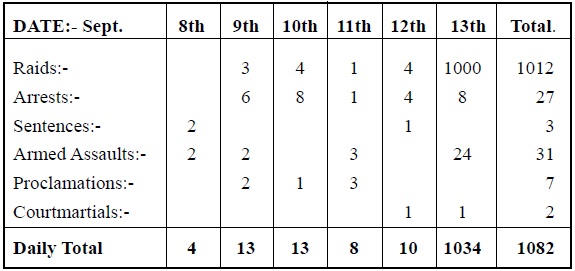
During the foregoing six days English Military terrorism in Ireland reached its high water mark. The town of Fermoy was sacked by English Military, English troops appeared on the streets of Dublin and shot down four young men. The English representatives in Ireland decreed the suppression of the elected Government of the Irish people; the vast army of occupation was set loose upon the nation and forcibly entered the houses of over a thousand of its respected citizens. [read more …] “Lest We Forget 7”
Lest We Forget (6)
[Continuing our series on the events of 1919 with the help of the daily newspaper of the First Dail, the Irish Bulletin.]
THE FOLLOWING ARE ACTS OF AGGRESSION COMMITTED IN IRELAND BY THE POLICE AND MILITARY OF THE USURPING ENGLISH GOVERNMENT – AS REPORTED IN THE CENSORED DAILY PRESS— FOR WEEK ENDING:- 16th AUGUST, 1919.
| DATE:- August | 11th | 12th | 13th | 14th | 15th | 16th | Total. |
| Arrests:- | 7 | 2 | 2 | 4 | 15 | ||
| Sentences:- | 5 | 1 | 1 | 3 | 10 | ||
| Armed Assaults:- | 3 | 1 | 1 | 5 | |||
| Militarism:- | 1 | 1 | |||||
| Suppressions & Proclamations:- |
2 | 3 | 6 | 1 | 12 | ||
| Courtmartials:- | 3 | 8 | 1 | 12 | |||
| Raids:- | 20 | 2 | 1 | 1 | 13 | 37 | |
| Daily Total | 37 | 6 | 10 | 17 | 6 | 16 | 92 |
Sentences for the week, as reported in Press, amounted to 52 months imprisonment.
MONDAY, AUGUST 11th, 1919.
Raids:- Large forces of police and military, fully armed, forcibly
entered and searched many houses situated upon the left bank
of the river Shannon. Upwards of 20 houses were thus raided
and searched.
Arrests:- Two men, whose names have not transpired were arrested near Portmore, Co. Armagh, because they participated in a Republican meeting which was proclaimed by the English military.
Sentences:- Michael and Timothy Spillane of Carrigaha,Castlegregory, Michael Flynn and Michael Griffin of Cappananee, and Michael Maunsell of Duagh all of the Co. Kerry, were sent to prison until December to await trial for the “attempted murder” of two policemen who were not even wounded. The five men indignantly protested their innocence but upon the evidence of policemen the paid magistrate committed them to prison. [read more …] “Lest We Forget (6)”
New Police Order
Lest We Forget (4)
LEST WE FORGET (4)
THE FOLLOWING ARE ACTS OF AGGRESSION COMMITTED IN IRELAND
BY THE MILITARY AND POLICE OF THE USURPING ENGLISH GOVERNMENT, AS REPORTED IN DAILY PRESS, DURING THE WEEK ENDING, JULY 12th, 1919.

ATROCITIES.
Monday, 7th July, 1919.
Discharged without trial: Mr. Patrick O’Brien, one of the three brothers arrested on suspicion in connection with the Silvermines shooting, was released after being 18 months in custody.
Raids:- Extensive house-to-house searches were made over large areas to the North and West of Newmarket, Co. Cork, by fully equipped British military and police. The raiders were accompanied by military wagons, armoured cars, and Red Cross cars, filled with armed soldiers. Two old disused shot-guns – the sole result of the raid – were found and commandeered.
Proclaimed. The annual Tipperary Feis (Gaelic League Festival) to be held in Thurles on Sunday last, was proclaimed by the British authorities on Friday. Large forces of military and police, with full war equipment, were drafted into the town on Sunday. The promoters decided not to hold the Feis, although such a course resulted in heavy financial loss to them.
Tuesday, 8th July, 1919.
Arrests.
Austin Geraghty and Peter J. Loghlon, Doolin District, Co. Clare, were arrested by British military and police in connection with the shooting of two R.I.C men near Kilfenora, Co. Clare. Michael Byrne, Camlough; Patrick Osborne, Gib Street, Belfast; Owen MacCroosh, Eshavany, and Patrick McShane, Cross, were arrested in connection with an alleged assault on two R.I.C. men at Camlough, Co. Armagh on Sunday last. They were brought before a Special Court at Camlough Barracks and remanded to Forkhill Petty Sessions on the 12th August. John Mahon, Gurteen, Newtownbarry, Co. Wexford, was arrested for failing to pay a fine imposed on him for collecting funds for Dail Eireann without a Permit from the British authorities. He has been “wanted” for some time on this charge. Robert Hegarty, 3 Kimmage Road, Dublin, was arrested on a charge of illegal drilling, and remanded in custody until Friday next.
Proclamation:- Sinn Fein, Sinn Fein Clubs, Cumann na mBan, the Irish Volunteers, and the Gaelic League in the County Tipperary were “prohibited and suppressed” by Proclamation published to-day. Two Proclamations were issued by the British Authorities, the first to cover the suppression in the North Riding area of Co. Tipperary, the second to cover the suppression of the South Riding area. An Aeridheacht announced for Castlepollard on Sunday last was proclaimed and large forces of British military and police were drafted into town to enforce the proclamation. Military guards were placed on all the approaches to the town. A meeting was held at the Market Square and was addressed by Mrs. Sheehy-Skeffington.
Armed Assault:- A District Inspector with a force of fully armed police came on the scene and ordered the dispersion of the meeting. On being asked for his authority the D.I. ordered a baton charge. Several people were injured in the charge, and the crowd retaliated with stones. The D.I. then ordered the police to fire, and for a time matters looked very serious. For some reason the police failed to obey the order, and after a time the people dispersed quietly in spite of the great provocation. After the arrest of John Mahon at Newtownbarry (vide above) a crowd numbering about 300, collected and boohed and hissed the police. Four or five police rushed out of the barracks and attacked the crowd with batons. A small number of the crowd were dispersed, but the large majority held their ground, with the result that a regular melee ensued. In the meantime a military wagon of British soldiers arrived on the scene. They fixed bayonets and charged the crowd, with the result that a large number of people were wounded. [read more …] “Lest We Forget (4)”
LEST WE FORGET (3)
(Continuing our series on typical events of 1919 with the help of the First Dail’s newspaper, the Irish Bulletin)
LEST WE FORGET (3)
THE FOLLOWING ARE THE ACTS OF AGGRESSION COMMITTED IN IRELAND BY THE MILITARY AND POLICE OF OUR USURPING ENGLISH GOVERNMENT DURING THE WEEK ENDING JUNE 14th 1919

MONDAY, JUNE 9th, 1919
Arrests:- Mr. Michael O’Connell, Main Street, Thurles, was arrested and sent under strong escort to Cork Jail. The charge has not been mentioned.
Raids:- Three houses were raided at Thurles, Co. Tipperary. The five Railway Stations in Cork were raided by armed police, late at night, and searched.
Sentences;- Bryan Shanahan, Grantstown, Co. Tipperary, was sentenced to four months imprisonment for “being suspected of having an intention to commit an illegal act.” The evidence against Mr. Shanahan was that he answered police questions in Irish and had possession of the key of a house in which two Irish Volunteers Uniforms were kept. Dr. T.F. Higgins of Maryborough was sent to gaol for one month for failing to admit police to a Language Movement Concert.
Murder:- Mr. Matthew Murphy, shot on the 4th June by a sentry posted without notice outside Dundalk died of his wounds. [read more …] “LEST WE FORGET (3)”
Lest We Forget (2)
LEST WE FORGET (2)
Continuing the series to commemorate centenary events of 1919 with the help of the First Dail’s newspaper, the Irish Bulletin. The Bulletin reported that from May 1916 to January 1919 the Crown Forces had carried out the following actions: 51 murders, 2,064 deportations, 99 assaults on civilians, 713 raids on houses, 4,785 arrests, 1,460 sentences, 51 proclamations and suppressions of meetings, fairs, markets etc., 28 newspapers suppressed and 322 court-martials. And of course these were for reported actions and not therefore complete. The following lists are samples of the weekly actions for the first weeks of May and June 1919.
Detailed list of the Acts of Aggression committed against the Irish people by the British military forces in Ireland during the short period of the visit of the Irish-American Peace Delegation, which extended from
May 2nd to May 12th, 1919
N.B. In order not to disclose the real methods by which Ireland is held in subjection the English commanders in Ireland held their forces in some restraint during the period mentioned. The following list, therefore, though it may surprise foreign peoples is not fully indicative of the tyranny which is practised from day to day upon the people of Ireland. [read more …] “Lest We Forget (2)”
Boys of the County Cork
Today marks the 100th anniversary of the War of Independence. Congratulations to the Presentation National School who marked the anniversary with a wonderful rendition of the Boys of the County Cork:
While it was not clear in the beginning of 1919 that the Dáil ever intended to gain independence by military means, and war was not explicitly threatened in Sinn Féin’s 1918 manifesto, an incident occurred on 21 January 1919, the same day as the First Dáil convened. The Soloheadbeg Ambush, in County Tipperary, was led by Seán Treacy, Séamus Robinson, Seán Hogan and Dan Breen acting on their own initiative. The IRA attacked and shot two RIC officers, Constables James McDonnell and Patrick O’Connell, who were escorting explosives. Breen later recalled:
…we took the action deliberately, having thought over the matter and talked it over between us. Treacy had stated to me that the only way of starting a war was to kill someone, and we wanted to start a war, so we intended to kill some of the police whom we looked upon as the foremost and most important branch of the enemy forces. The only regret that we had following the ambush was that there were only two policemen in it, instead of the six we had expected.[33]
This is widely regarded as the beginning of the War of Independence. [read more …] “Boys of the County Cork”
Lest We Forget (1)
In this decade of commemorations we are encouraged to remember and not to forget. Very good advice and we will do our bit during the hundredth anniversary of “the four glorious years” to recall the facts of those years. We will do so with the help of the “Irish Bulletin”, the daily paper of the Dáil.
There could not be a more appropriate source as the whole object of the War that Britain engaged in was to destroy that Dáil. This is history from the horse’s mouth.
People who set up the Bulletin published lists of atrocities before it was officially launched in November 1919 and did so afterwards as well. Below is a list for 1919 and early 1920. It is not all comprehensive as it relied to a large extent on newspaper reports which were all censored and dozens suppressed and before the Bulletin had established a network for receiving news of atrocities independent of the press. Later lists will show much more comprehensive listings for the period covered here.
However, it gives the flavour of the ongoing terror campaign in period it covers and confirms the “existing state of war” as described in the Dáil’s Declaration to the Free Nations of the World on 21 January 1919.
OUTSTANDING INCIDENTS OF ENGLISH AGGRESSION IN IRELAND
From January 1st 1919 to April 30th 1920
(In the majority of cases the dates given are those upon which the incidents were reported in the daily Press)
January 1919
7th People of Dunmanway, Co. Cork, attacked by soldiers and police with rifles, fixed bayonets and batons.
27th Police with fixed bayonets attacked a crowd at Baltinglass which had assembled to welcome home a political prisoner.
February 1919
11th Police forced doors of King’s County Council Offices and attacked Council staff with bayonets.
12th Patrick Gavin shot dead by soldiers at Curragh camp.
19th Soldiers attacked card party at the Temperance Hall at Annacarty, County Tipperary, and wrecked the Hall.
20th Timothy Connors, Greenane, Co. Tipperary, aged 11 years, kidnapped by police and secretly taken to unknown destination, his parents being refused all information. [read more …] “Lest We Forget (1)”
Captain Paddy McCarthy – Killed at Mill Lane on November 22nd 1920
Captain Paddy McCarthy
(8/Feb/1896-22/Nov/1920)
The late Paddy McCarthy was born at Rowels, Meelin and reared with his cousins, the Fitzpatricks of Commons, Freemount. He became an active member of Óglaigh na hÉireann following the 1916 Easter Rising, and was a member of B Company of the Second Battalion, Cork No. 2 Brigade of the IRA under Sean Moylan.
On May 8, 1918 he was charged with a gun offence and imprisoned for 18 months. He was held in Belfast prison where he took part in the hunger strike of 1918. He and others were transferred to Strangeways prison in Manchester where he made a daring escape with Austin Stack of Tralee and four others in 1919.
====
He took part in the capture of Mallow Barracks in September 1920, which was the only military barracks to be taken over in the war.
“It was planned that Willis and Bolster would enter the military barracks that morning in the normal way, accompanied an officer (Paddy McCarthy) of the column who would pose as a contractor’s overseer.
McCarthy, Willis and Bolster entered the barracks without mishap, their revolvers concealed. Members of the garrison followed their normal routine.
Inside the walls were Paddy McCarthy, Dick Willis and Jack Bolster, their revolvers concealed. Then Ernie O’Malley presented himself at the wicket with a bogus letter in his hand. Behind him and out of sight of the sentry were the other members of the main attacking party, led by Liam Lynch, Paddy O’Brien and George Power. When the gate was opened sufficiently, O’Malley wedged his foot between it and the frame and the soldier was overpowered. In rushed the attackers.
McCarthy, Bolster and Willis immediately went to the guardroom where they held up the guard. Realising what was happening, Sergeant Gibbs, rushed towards the guardroom in which rifles were kept. Although called upon to halt, he continued even though a warning shot was fired over his head. As he reached the guardroom door, the I.R.A. officer and one of the volunteers in the guardroom fired simultaneously. Mortally wounded, the Sergeant fell at the guard-room door.
By that time the majority of the attacking party was inside the gate. Military personnel in different parts of the barracks were rounded up and arms were collected. Three waiting motor cars pulled up to the gate and into them were piled all the rifles and other arms and equipment found in the barracks. In all some twenty-seven rifles, two Hotchkiss light machine-guns, boxes of ammunition, Very light pistols, a revolver, and bayonets, were taken away. The prisoners were locked into one of the stables, with the exception of a man left to care for Sergeant Gibbs. The whole operation had gone according to plan, except for the shooting of the sergeant.” [details]
====
Captain McCarthy met his fate on Mill Lane on the night of the 22nd November 1920, when his Flying Column took on the British Forces in Millstreet:
After atrocities on local residents by the Auxiliaries, the leaders of the Cork No. 2 Brigade column decoded to attack them on November 22nd 1920. William Reardon recalled: ‘When we had been in position for some time, there was no sign of any activity, but suddenly someone dashed past the end of Mill Lane, at the same time firing a shot. We rushed onto the Main Street at the junction with Mill Lane and opened fire on two Black and Tans who were running up the street towards their barracks. The enemy party escaped, but when we returned to Mill Lane, we found that Paddy McCarthy had been shot dead by the single shot.’
Paddy McCarthy is the first name on the monument in the Square. Annually the local Sinn Féin Cumann hold a commemoration in honour of his selfless dedication and service to his country.
For more, read the speach given at the 2006 commemoration by Jack Lane of the Aubane Historical Society.
======================
Paddy McCarthy – Died 1920
Born Meelin, Co. Cork. Shot dead at Upper Mill Lane, Millstreet on November 22nd. 1920 by Black and Tans. Had joined Volunteers immediately after 1916. Took part in Belfast hunger strike in 1918 under Austin Stack. Escaped from Strangeways Jail, Manchester in September 1919. Played decisive part in capture of Mallow Barracks and at Ballydrochane ambush, near Kanturk. Was buried with full military honours at Lismire, near Kanturk. – from Second North Cork Brigade
======================
Volunteer Patrick McCarthy of Meelin, Newmarket (Millstreet)
Date of incident: 22 Nov. 1920
Patrick McCarthy was ‘a leading North Cork fighter who played an important part in the capture of Mallow Military Barracks. A short time afterwards he fell in action in a fight at Millstreet.’ On 22 November 1920, Volunteers from the Millstreet Battalion and the column of the Cork No. 2 Brigade attacked the forces of the crown, which had been terrorising the nationalist population of Millstreet. According to Volunteer and column member Seán Healy, ‘the Black and Tan garrison in Millstreet were making themselves very objectionable to the public. They were visiting public houses, demanding and getting free drinks, smashing windows, and damaging doors. It was decided to teach hem a lesson, and so the column, in conjunction with members of local companies, who were acting as scouts, moved into positions in the town of Millstreet about 9 p.m. on 22nd November 1920.’ See Seán Healy’s WS 1339, 8 (BMH).
The decision by leaders of the Cork No. 2 Brigade column to attack the Auxiliaries recently arrived in Millstreet was prompted by the bombing of the house of Volunteer William Reardon and the attempted burning of the houses of Timothy Murphy and Mrs Lenihan on 20 November 1920. The Auxiliaries must have been anticipating such a reprisal. As one of the attacking Volunteers William Reardon, recalled, ‘When we had been in position for some time, there was no sign of any activity, but suddenly someone dashed past the end of Mill Lane, at the same time firing a shot. We rushed on to the Main St at the junction with Mill Lane and opened fire on two Black and Tans who were running up the street towards their barracks. The enemy party escaped, but when we returned to Mill Lane, we found that Paddy McCarthy had been shot dead by the single shot.’ See William Reardon’s WS 1185, 5 (BMH).
The IRA unsuccessfully sought to avenge McCarthy’s death: ‘Every night for the next week we moved into the town [of Millstreet], but the Tans made themselves conspicuous by their absence and confined themselves severely to the barracks. On the last night we went in, we brought the Hotchkiss [gun] into a dressmaker’s shop facing the barracks and fired a series of volleys into the barrack windows and door. They made no effort to come out.’ See Richard Willis and John Bolster’s WS 808, 25 (BMH).
McCarthy’s comrades removed his body to the house of Eugene O’Sullivan at Gortavehy, 5 miles away, where it was waked through the night and carried off for burial in Kilcorcoran Cemetery the next day. Liam Lynch personally took charge of the funeral arrangements. See Rebel Cork’s FS, 201. In the words of Seán Moylan, ‘It was an eerie experience following a coffin at midnight along lonely bye-roads from Millstreet to Kilcorcoran. And in spite of the secrecy with which the proceedings had to be veiled, the funeral cortege at Kilcorcoran had reached immense proportions. Men seemed to come from everywhere to pay their last tribute of respect to the dead soldier, and our loyal friend, Father Leonard from Freemount, came to say the last prayers at the graveside.’ See Seán Moylan’s WS 838, 147-48 (BMH). Almost two years later, McCarthy’s body was exhumed with extraordinary ceremony and reinterred in the family burial ground at Clonfert near Newmarket in October 1922: ‘The coffin lay overnight in his native church, Meelin, with an all day and night guard in relays. The funeral cortege was over three miles long. It reached from Clonfert to Meelin. The volleys fired over the grave were heard in Meelin, and the funeral procession was still moving out of the village.’ See Denny Mullane’s WS 789, 16 (BMH)
Seán Moylan, his close comrade, recalled McCarthy’s IRA career and personality: ‘Paddy McCarthy had been arrested after a battalion parade in March or April 1918. He was sentenced to eighteen months in Belfast prison. He participated in the strike there under Austin Stack. Afterwards he was transferred to Strangeways prison, Manchester, from which he escaped about September 1919. From the date of his arrival home in Ireland until August 1920, when he was selected as a member of the newly organised A.S.U., he had been associated with me in all activities. Now I was no more to see his friendly face, to hear his merry laughter, to have my spirits renewed by his unbreakable courage.’ McCarthy, declared Moylan, ‘had so much of dare-deviltry, was so infectiously gay and good humoured that he was an all-round favourite, and his death was the sorest blow that could be given to them [i.e., his comrades]’. See Seán Moylan’s WS 838, 147-48 (BMH). – [The Irish Revolution]
======================
“Do you remember our Quartermaster Paddy McCarthy? He was killed in a fight with Tans in Millstreet. Paddy O’Brien was wounded by an ambush of Tans near his own place. He ‘ s now Brigade Quartermaster. ” Paddy McCarthy was a loss. I thought of his unfailing good humour , his broad laugh and the lilt of song that would burst out at unexpected times. His quartermaster’s magic sack would no longer open to disgorge ammunition, cigarettes or mine batteries. – Irish Press 1937
=====================
The War of Independence in Freemount
In 1917 a company of the Irish Volunteers was formed in Freemount. As the company were in the Newmarket battalion area, they later became ‘B Company, Newmarket Batallion, Cork No.4 Brigade’.
In 1918 Sean Noonan a creamery manager in Freemount was arrested along with Paddy McCarthy, a native of Meelin who resided with his cousins, the Fitzpatricks of Commons. They were charged with possession of fire arms and both were sentenced to terms of imprisonment in Belfast Jail.
McCarthy was deported to Manchester prison from which he made a daring escape with Austin Stack of Tralee and four others. He then became a member of the Brigade Flying column and took part in the capture of Mallow Military Barracks, he was killed in a fight with the Black & Tans in Millstreet on November 22~ 1920… [Freemount Village]
======================
In 1947 a plaque was erected to Paddy McCarthy at the corner of Mill Lane and Main Street in Millstreet. He is commemorated there each year. [maps]
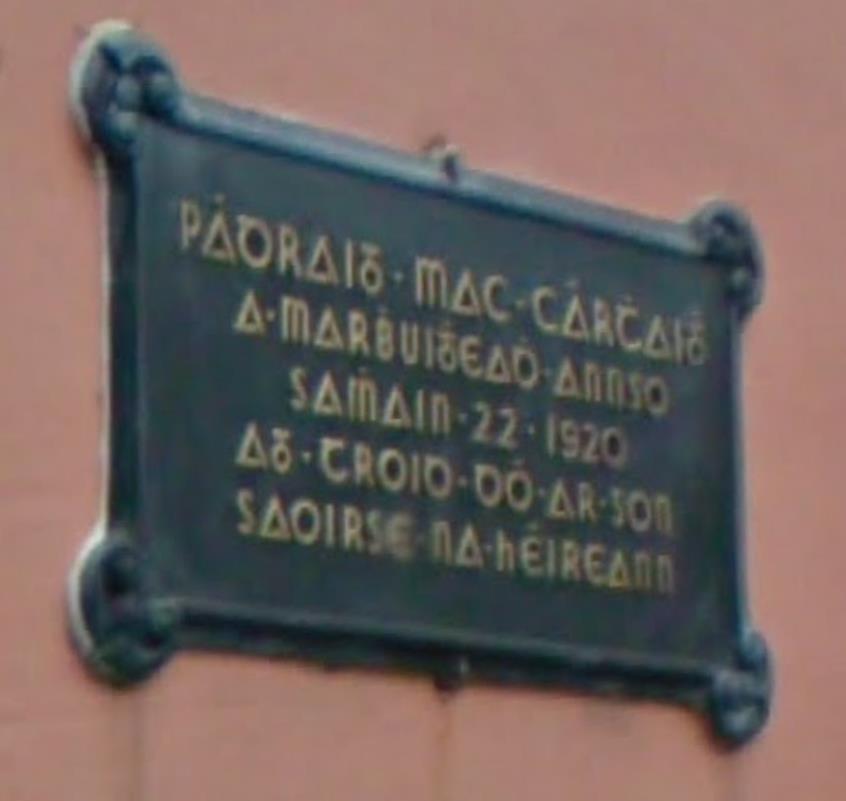
It reads: “Pádraig Mac Cárthaigh a marbhuigheadh annso Samhain 22 1920
Ag troid dó ar son saoirse na hÉireann”. (Patrick Mac Carthy was killed here on November 22 1920. Fighting for Irish freedom).
TODO: plaque unveiled at mill lane 1947 … where is the article that was being prepared?
======================
Paddy McCarthy is the first name on the monument in the Square.


======================
Named after him, Captain Paddy McCarthy Terrace is across from the Cannon O’Donovan Centre, back the Clara Road

=====================
There is a plaque to Paddy McCarthy directly across from the Church in Meelin [maps] [f]

=====================
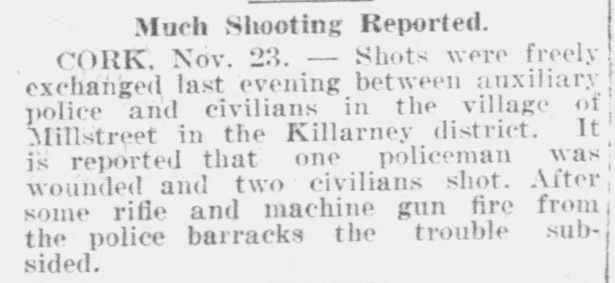 — The Brattleboro daily reformer., November 23, 1920
— The Brattleboro daily reformer., November 23, 1920
=======================
Paddy McCarthy story resembles Bugle
WHILE the central theme in Bryan McMahon’s play, ‘ The Bugle in the Blood’ deals with a son, Robby Trimble who is on hunger strike and the moral dilemmas coupled with the rights and wrongs of self sacrifice as seen through the eyes of his family.
While the play is set in Meelin by the Duhallow Players as part of the Meelin Rising Commemoration celebrations, there is an uncanny slice of history which resembles the play on home ground.
The director Michael O’Halloran who also plays a key role in ‘ The Bugle in the Blood’ uncovered a very appropriate Meelin connection with the subject mater of the play through the Volunteer leader, Paddy McCarthy, who was born in Meelin and joined the Volunteers immediately after 1916.
He was a key figure in the second Brigade IRA (North Cork) but it might not be generally known that he himself joined the hunger strike in Belfast in 1918 under Austin Stack.
He escaped from Strangeways Jail in Manchester in September 1919 and secretly returned to Ireland and made his way to O’Reilly’s undertakers in Newmarket which was a safe house.
Mrs O’Reilly, who is a grandmother of Michael, who runs the business today, was washing clothes in the back yard when she saw a very gaunt man make his way into a secret cellar underneath their house in Church Street.
McCarthy was so emaciated that she failed to recognise him, but she went to the door and gave an agreed knock – which he answered.
She then secretly and kindly fed and looked after him there in the following weeks, until his strength returned.
However, he was later shot in Millstreet and secretly buried at night in Kilcorcoran cemetery in Lismire. His body was later exhumed and there was a funeral mass in Meelin and he was buried in Clonfrert with full military honours.
The Bugle In The Blood which was presented by Duhallow Players in Meelin Hall, Sunday 24th and Thursday 28th to Saturday 30th April 2016 at 8pm.
[The Corkman ]
===========================
Escape from Strangeways Jail in Manchester
Piaras Beasley, in his book – “Michael Collins And The Making Of A New Ireland” – stated, regarding the escape from Strangeways Jail, Manchester, in October, 1919, that there was no effort to arrange an escape until he arrived, and that he started it. In this, Piaras Beasley has made a mistake. As a matter of fact, several, communications had passed between Stack, who was a prisoner in Strangeways Jail, and Collins about a possible escape. Eventually, it was decided that nothing would be done until Beasley was tranferred. there from Birmingham Prison. I was the first to take a note from Collins to Beasley; and his first remark to me was: “I am glad you have been busy here” – which showed there was previous contact.
At this time, Fionán Lynch, who was a prisoner also, was released; and he brought out a map showing the location of where a possible attempt at escape could be effected. Fionán was in close touch with Paddy Donoghue and myself; and we, of course, were working in close touch with Michael Collins.
At that time, of course, we had no friendly warders. All communications with the Manchester prisoners were mostly delivered by visitors. They were shown in to a room there. In shaking hands, they could transfer anything, or, as very often happened, in pots of jam and parcels of butter taken in by Mrs. Donoghue, The plan of the outside of the wall was sent in on a map, packed in a cake again.
This was done in Paddy Donoghue’s house. Rory O’Connor came to Manchester to examine the plans of the proposed escape. The code which was used was that Collins was “Ange1a”, and Paddy Donoghue was “Maud”. The six prisoners in Manchester at the time were Austin Stack, Piaras Beasley, D.P. Walsh, Seán Doran, Con Connolly and Paddy McCarthy, who was afterwards killed in an ambush. The plan was to hold up the warder during exercise; and we had got handcuffs, in case they were necessary, from Inspector Carroll of the Salford Dock Police, with, of course, the numbers rubbed out so that they could not be traced, The day of the proposed escape arrived, and it was found that the Volunteers from Dublin, under Rory O’Connor, missed some connection. The escape had to be arranged for a later date. The morning of the actual escape arrived. Miss Talty took in a watch to the prison. This watch had been sent out for repairs, but actually it was brought in to have the correct time recorded, so that there should be no hitch. The time would have to synchronise with that recorded on the watches outside – five o’clock.
As Beasley has pointed out in his book, I was unable to be present, because I was, at the time, laid up with an attack of the ‘flu. The street at the back of the prison led on to a croft; and this was mannedby a number of Volunteers from Dublin, Liverpool and Manchester, holding up all traffic and all pedestrians, including military. At the specified time, a stone was thrown over the wall from inside. This was the zero hour than, and a rope, leaded, was thrown over the wall from the outside. It only went a couple of feet over the wall; and it had to be hauled back again. The same thing happened the second time.
Eventually, Matt Lawless, a member of the Volunteers, walked up with an extension ladder and calmly put it up against the wall. Peadar Clancy mounted it, released the weight and threw over the ladder. The first man up was Stack. The second was Beasley himself; and when he had got to the top, two more had got to the bottom of the ladder; his hands got stuck; they were scraped and grazed; eventually he succeeded in landing on the ground. All six prisoners got out. Beasley and Stack were taken to a waiting motor car by Donoghue, and driven to the house of a man, named George Lodge, Bachelor of Science, and employed by the I.C.I. at the time.
Two of the prisoners, Seán Doran and Paddy McCarthy, were given bicycles, and in the excitement they missed their guide. They set off, one following the other – one thinking that the other was the guide – until they found themselves out in the suburbs. They did not know Manchester, and had no idea what to do. They went in to the F.C.J. (Faithful Companions of Jesus) Convent there. There was a conference of old members in progress. They told their tale. One of the ladies present was a Miss Josie O’Donnell from Rochdale; and she was advised to go and see the Parish Priest, Father Corkery. She told him her tale of woe – that she had the two prisoners, and did not know what she was to do with them. Where did he suggest that she could. go, but the place where we had Stack and Beasley staying – George Lodge’s. She brought the two lads – Doran and Paddy McCarthy – and left them waiting some distance away. She knocked at the door. It was an hour after the arrival of Stack and Beasley. When the door was opened, she said: “Are you Irish?” He said: “Yes”. She said: Are you a Catholic?” He said: “Yes”. She said: “Are you a Sinn Féiner?” He said: “No, no, not at all” – thinking of the men he had from Strangeways. So she said: “Do you know anybody in the Sinn Féin movement?” And eventually she asked him if he knew me. He said: “No, I never met him. Wait – I think his name was in the Catholic Herald at a meeting”.
He was not long gone when he came back, and gave her my name and address. George thought it was all lost and the plot was found out.
She came to our house with the two lads. They planked their bicycles’ some distance away. She knocked at the door. My wife answered the door and, although they went to college together, they did not recognise one another; they had not seen each other for a long time. The same questions were put again – “Are you a Catholic?” “Are you Sinn Féin?” My wife said: “We belong to the Self-Determination League”. So Miss Talty went out, and knew Josie very well. She told us what had happened, and that the two lads were outside. I had a brother-in-law, who was visiting me then because I had the flu, and I told him to take them up to his place until we arranged about them. They were taken to 64 Alexander Road – Seamus Talty’s place. – [Collins 22 Society]
========
James Hickey’s Bureau of Military History statement about the time of Paddy McCarthy’s murder:
“…At this stage Paddy McCarthy suggested that there was little likelihood of any more activity and “Neilus,” Healy proceeded to the junction of Mill Lane with Main St. to have a look round. As he reached the junction he noticed two people leaving Nicholson’s public house at the opposite side of the street. We returned immediately and reported accordingly. We were then about 20 feet from Main St., and as the message was being conveyed by “Neilus” Healy a shot rang out and Paddy McCarthy dropped. He had been shot through the head and was killed outright…”
==========
TODO: which RIC officers were responsible?
When Millstreet was declared part of new Special Military Area
On this day one hundred years ago (Oct 5th 1918) West Cork Riding was declared Special Military Area. Nobody could enter area without a permit from the military authorities in Bandon. Measure was a direct (albeit belated) response to July 1918 Irish Volunteers Beal an Ghleanna Ambush that left 2 policemen injured. It was the first attack on the RIC since 1916. Fairs, markets, commercial travel and other business were severely restricted over the following months, as was personal travel, with military checks at trains arriving into stations on the many rail lines running through West Cork a century ago. West Cork Riding covered most of west half of county; not west Cork as we think of it today. Very roughly, imagine a diagonal line running from immediately west of Kinsale, through area west of Rylane, then, between Millstreet and Banteer, turning west toward Kerry.
[read more …] “When Millstreet was declared part of new Special Military Area”
Roger Kiely – The Men of the South
Roger Kiely (principal of Cullen National School 1938-1961) is the central figure on the cover of a new book from UCC entitled the “Atlas of the Irish Revolution“, but for some reason best known to the editors they did not have the courtesy to identify him. He was an intelligence officer with the Millstreet Battalion.
They might have included the description of him by the artist Sean Keating: “Roger Kiely was about the best and finest man I ever knew. A few years ago I went to look for him in County Cork. I found him a poor school-teacher in a poor little school near Kanturk. I asked him about the others and found that death, poverty and America had claimed them – the Unknown Soldiers.” (BMH Witness Statement 505). – Jack Lane [read more …] “Roger Kiely – The Men of the South”
The Killing of Michael Dinneen
 Early on the morning of the 24th of June 1921 I.R.A. Volunteer Michael Dineen from the Kilcorney Company County Cork was taken prisoner by Auxiliaries in a round-up of I.R.A. suspects. He was picked up at his brother’s house Ivale, and his body was later found at Tooreenbawn some three hundred yards from his home he had been shot.
Early on the morning of the 24th of June 1921 I.R.A. Volunteer Michael Dineen from the Kilcorney Company County Cork was taken prisoner by Auxiliaries in a round-up of I.R.A. suspects. He was picked up at his brother’s house Ivale, and his body was later found at Tooreenbawn some three hundred yards from his home he had been shot.
“About 7 a.m. on Friday, June 24th., I noticed some Auxiliaries and a policeman at a little distance from my house. I have since ascertained that the policeman’s name was Dowd. I called my brother, Michael, who was in bed. He got up and dressed, and was saying his morning prayers when the Auxiliaries came in. They questioned him and charged him with being in the Rathcoole Ambush on the previous week, and with being an officer in the I.R.A., all of which was untrue, and which he denied. Then they took him out of the house and one of them went to his room, searched it and took some money. When this man came downstairs he ordered my brother to be brought in again, and questioned him about Sinn Fein, etc, and said: “I’m going to shoot you because you must be an officer in the I.R.A.” “If you do,” said Michael, “I can’t help it. I suppose you shot as innocent men as me.” He ordered Michael to be brought outside [read more …] “The Killing of Michael Dinneen”

